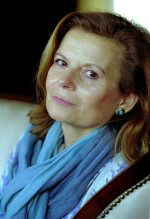Writers and Barcelona
Barcelona has been and keeps being a perfect scene for literary works, a source of inspiration for writers who were born here and a welcoming place for writers from around the world who have described it in their books.
Catalan Spanish language writer. She met Jaime Gil de Biedma, Gabriel Ferrater and José Agustín Goytisolo at university, and began work at Seix Barral publishers after graduating in Hispanic Philology. In Luna lunera, her most auto-biographic novel, she portrays post-war Barcelona through a family of the Catalan bourgeoisie, the Vidal Armengol family, for which she won the City of Barcelona Award. In 1994, she received the Premi Nadal Award for Azul, featuring Andrea as main character, the same name as the main character in Nada, winner of the Nadal Award fifty years previously. The novel is set between Barcelona, New York, Cadaqués, and Castellorizo. She formed part of the Escola de Barcelona and of the Gauche Divine.
Journalist, literarture teacher and writer, Joan Rendé was the famous Doctor Scopius from the AVUI journal in the 80's, was member of the literary collective Ofèlia Dracs and wrote radio and television shows such as "Oh, Bongònia". He has won some big literary awards: Víctor Català, Mercè Rodoreda and the Crítica Serra d'Or Award. His last novel is Els anys de la serp (2017).

Novelist, scriptwriter, and essayist. She settled in Barcelona in 1968 where she graduated in Hispanic Philology, but it wasn't until 1980 that she began her writing career with Una primavera para Domenico Guarini, set in Barcelona. In La meitat de l’ànima”, a reflection on literature and memoires, the story begins during a Saint George’s Day celebration in Barcelona.
She is one of the finest Catalan literature novelists of the twentieth century. As a young girl she would close herself away to write in a pigeon house at her home on Carrer Manuel Angelon, in the neighbourhood of Sant Gervase de Cassoles. Her literature has very close ties with the city: In Diamond Square, Camellia Street, Aloma, and A Broken Mirror, although much of it was written during her time in exile in 1939. Cultural Centre Òmnium Cultural has been awarding the Mercè Rodoreda literature prize since 1998 on the Night of Saint Llúcia.
Writer and journalist. Raised in an intellectual environment, her novels are set during the post-war period in Barcelona’s Eixample district. She was a woman who broke with traditional ideals, and one of the first newspaper columnists with a feminist vision. Libraries, institutes, and streets have been named after her. Since 2017, the Barcelona City of Literature Office has been awarding Montserrat Roig grants for writers.
Writer, architect, and columnist, she is author of the novels Primavera, estiu, etcètera (2011), her bestseller receving excellent reviews, and L'altra (2014). She is also a regular contributor on VilaWeb. Some of her articles are published in No ens calia estudiar tant (2015).
Poet and narrator. Influenced by writer J.V. Foix i Gabriel Ferrater, he became consolidated as a poetic voice with his work La mel (2001). A mala vida he makes a generational portrayal of passive youth and of the darker side of Les Rambles.
Prominent novelist of the post-war period. He won the 1951 Nadal Award with La Noria, in which he reflects the life of Barcelonians in a twenty-four hour day. It became well-known as one of the most renowned pieces of work published during the post-war period and one of the most original works of the mid twentieth century in the Spanish language.
Writer and teacher at the Ateneu Barcelonès Writing School and at the Máster de Edición of the Universidad Pompey Fabra. With the novel Las voces del laberinto (2005) he was awarded the Premio Miradas given by the Fundación Manantial in 2006. In 2016 he won the Premio Ramon Muntaner of youth literature with the novel Herba negra and, in 2017, the Premio Edebé of children's literature for La inmortal. He has been vicepresident of the “Association of Cultural Journalists” and is part of the Board of the “Associació d'Escriptors en Llengua Catalana”
Painter, writer, collector, journalist, and playwright. He was one of the leading figures of Catalan modernism, a peer of Ramon Casas, Mossèn Cinto Verdaguer, Pompeu Fabra, Valle-Inclán, Manuel de Falla and Erik Satie. In his usual irreverent style, he wrote La niña gorda (1917) set in Torrent de l’Olla, and the same year he made his début with his theatre play L'auca del senyor Esteve written a decade previously, the story of a Barcelonian family from the beginning of the twentieth century, set in the district of la Ribera



